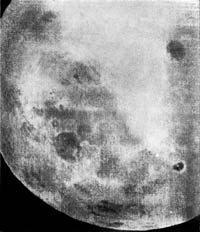 |
| 1959 - The Dark Side of the Moon |
To me what is so remarkable about this is the technology used. The probe was to be launched from earth, fly past the moon, and, as it did so, take a series of some 60 or images and transmit them to earth.
In 1959 computers were the size of semi-trucks or larger and required enormous amounts of power - so using a computer to control the mission was impossible.
So how did the Luna 3 orient its camera?
The Soviets built a complex system of photocells and relays that controlled small orientation jets. As the Luna tumbled through space the photocells would detect sunlight and, using a negative feedback system, fire a orientation jet in the opposite direction of the tumbling.
In order to process the pictures the Luna 3 had an internal atmosphere of Nitrogen maintained at about 25 degrees C. A small camera with a built in film development system was able to image pictures sequentially and move the film forward. The film then passed through a liquid chemical developer system (the temperature and atmosphere inside the Luna 3 was required for this) which developed the film and wound it onto a take-up roll.
Once on the take-up roll earth radio commands could cause the film to be scanned and transmitted to earth as a TV signal. This was accomplished with a scanning tube from an oscilloscope that slowly drew lines across the face of the tube. The light from the line passed through lenses to a photomultiplier tube which was attached to a system that encoded the signal for transmission to earth.
Scanning each image took about thirty minutes.
What's remarkable about all of this is how much the Soviets accomplished with so little technology.
The Luna 3 was only about six hundred pounds in weight, 51 inches long and about 38 inches around.
The only part of the entire process that required a computer as we know it today (a Strela-1 which performed some 2,000 floating point calculations a second) was the calculation of the launch trajectory. The Luna 3 had to be lanuched so that it would pass the far side of the moon, take its pictures, and then using the moon's gravity slingshot around and return past earth to transmit the pictures - the power of the on-board TV transmission system being very limited and unable to transmit from the location where the pictures would be taken (some 50,000 miles beyond the moon).
The rest system was designed with slide rules and hand calculations.
Even more remarkable is that the entire program - from conception to launch to receiving images took only a twenty one months.
One has to wonder why things are so complex today...
No comments:
Post a Comment